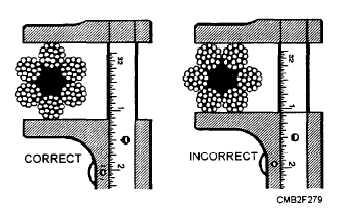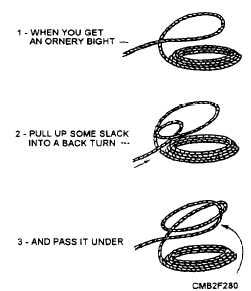Measuring Wire Rope
Wire rope is designated by its diameter in inches, as shown in figure 6-38. The correct methods of measuring wire rope is to measure from the top of one strand to the top of the strand directly opposite it. The wrong way is to measure across two strands side by side.
To ensure an accurate measurement of the diameter of a wire rope, always measure the rope at three places at least 5 feet apart. Use the average of the three measurements as the diameter of the rope.
Wire Rope Safe Working Load
The term safe working load (SWL) of wire rope means the load that can be applied and still obtain the most efficient service and also prolong the life of the rope. For the safe working load of wire rope, refer to the manufacturer's certification of published breaking strength or the actual breaking strength of a piece of wire rope taken from the reel and tested.
Wire Rope Failure
Some of the common causes of wire rope failure are the following:
Using incorrect size, construction, or grade
Dragging over obstacles
Lubricating improperly
Operating over sheaves and drums of inadequate size
Overriding or cross winding on drums
Operating over sheaves and drums with improperly fitted grooves or broken flanges

Figure 6-38. - Correct and incorrect methods of measuring wire rope.
Jumping of sheaves
Exposing to acid or corrosive liquid or gases
Using an improperly attached fitting
Allowing grit to penetrate between the strands promoting internal wear
Subjecting to severe or continuing overload
Using an excessive fleet angle
Handling and Care of Wire Rope
To render safe, dependable service over a maximum period of time, you should take good care and upkeep that is necessary to keep wire rope in good condition. Various ways of caring for and handling wire rope are described below.
COILING AND UNCOILING. - Once a new reel has been opened, it may be coiled or faked down, like line. The proper direction of coiling is counterclockwise for left lay and clockwise for right lay wire rope. Because of the general toughness and resilience of wire, it tends now and then to resist being coiled down. When this occurs, it is useless to fight the wire by forcing down the turn because it will only spring up again. But if it is thrown in a back turn, as shown in figure 6-39, it will lie down properly. A wire rope, when faked down, will run right off, like line; but when wound in a coil, it must always be unwound.
Wire rope tends to kink during uncoiling or unreeling, especially if it has been in service long. A kink can cause a weak spot in the rope that wears out quicker than the rest of the rope.

Figure 6-39. - Throwing a back turn.
Continue Reading